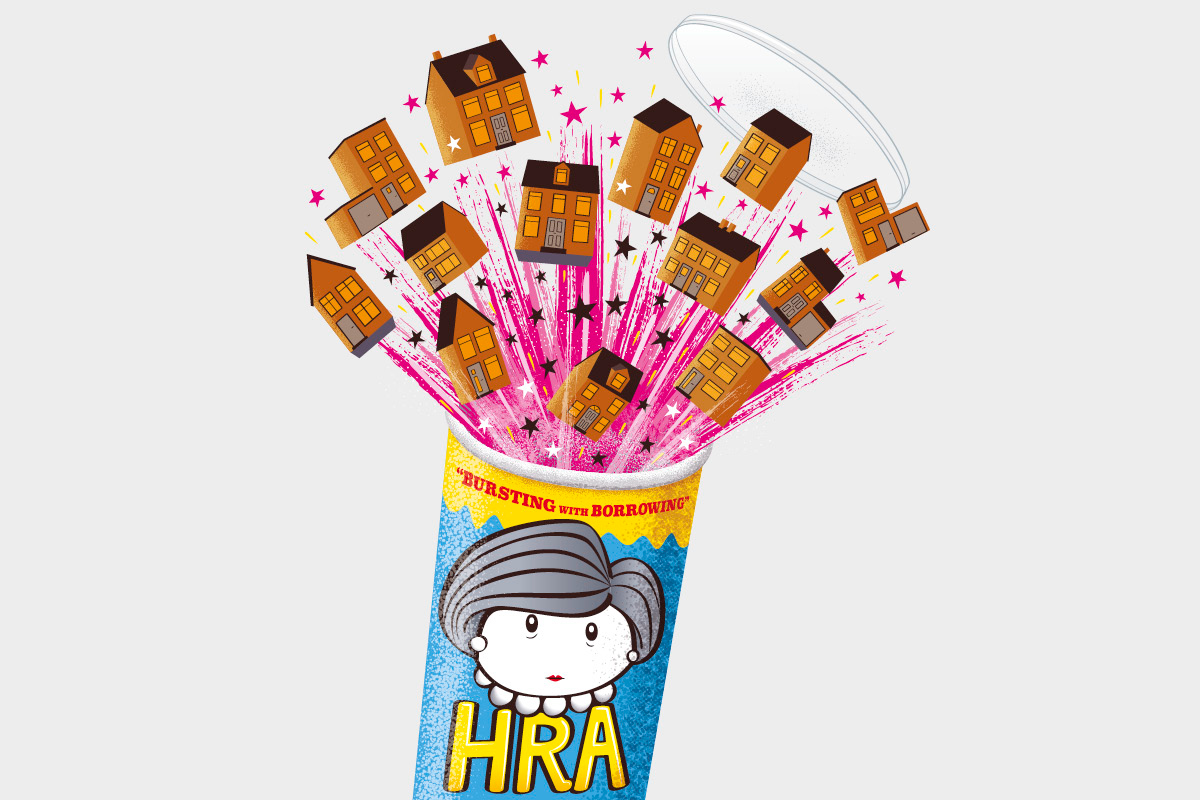Popping caps: common questions on the HRA announcement answered
A number of questions have sprung up in the aftermath of Theresa May’s council borrowing cap announcement. Nathaniel Barker seeks answers to some of them. Illustration by The Boy Fitz Hammond
“There is a government cap on how much [local authorities] can borrow against their Housing Revenue Account [HRA] assets to fund new developments,” Theresa May told the Conservative party faithful in Birmingham last week.
“Solving the housing crisis is the biggest domestic policy challenge of our generation. It doesn’t make sense to stop councils from playing their part in solving it. So, today I can announce that we are scrapping that cap.”
These were words that many local authorities across the country and of all political stripes have been hoping to hear a prime minister say for years. The sector’s immediate reaction was one of near-jubilation.
Lord Gary Porter, chair of the Local Government Association, confessed to being close to tears upon the declaration, and told Inside Housing it was “the single biggest change in social housing since Thatcher”.
The sector’s immediate reaction was one of near-jubilation
However, a number of key questions still need to be answered.
As the dust settles around Mrs May’s surprise announcement, we probe some of the most significant sticking points.
Firstly, to be clear for those who have not spent years lobbying for this precise change, the HRA is a ringfenced budget which effectively works separately to councils’ other operations, containing a local authority’s social housing stock. It takes its income from rents and service charges, and spends this money on building and maintaining homes.
Councils are also able to borrow money from the Public Works Loan Board within their HRAs for extra funding, but as part of the ‘self-financing’ deal introduced by the coalition government in April 2012 this ability was limited by a strict cap.
Many councils have already borrowed to the full extent of the HRA headroom, or very near. This, they argue, means their ability to borrowing money to invest in building new homes is greatly restricted.
That is, until now.
What’s the context?
In a nutshell: a recognition of the desperate need to build more affordable homes. But there’s plenty going on behind the scenes here.
The HRA borrowing cap was initially imposed alongside self-financing because of Treasury nervousness over the possibility that council debt – which appears on the public balance sheet – would begin to spiral if town halls were allowed to take on loans based on the value of sizeable asset bases.
Now, it’s understood that those holding the purse strings, including chancellor Philip Hammond, remain unconvinced at the prospect of another £1bn-or-so in borrowing, as estimated by civil servants.
There have been experiments with raising the cap in the past.
Bean counters may seek to re-shackle HRA borrowing if councils aren’t seen to be delivering on a brick-per-pound basis
A £300m programme announced by George Osborne in late 2013 was quietly wound down with just a fraction of the target homes built. That time local authorities complained extensive red tape surrounding the money blunted its usefulness. And at the last Autumn Budget, Mr Hammond offered authorities £1bn of extra headroom, with fewer strings attached.
Bidding for that programme closed just three days before Ms May’s announcement and is understood to have been swamped with demand.
That fact is thought to have significantly influenced the prime minister’s decision – indeed, the government itself has acknowledged as much – but the bean counters may seek to re-shackle HRA borrowing if councils aren’t seen to be delivering on a brick-per-pound basis.
Experts predict some form of formal demonstration of value for money as a condition of the borrowing – at the very least.
How many homes?
A vital question and the ultimate measure of the policy’s success – at least in the eyes of Number 10. The government has said removing the cap will deliver “up to an estimated 10,000 additional homes a year”.
Savills Housing Consultancy plumped for “at least” 15,000 a year based on analysis it carried out in November last year, while Shelter reckons the annual figure could reach as high as 27,500 units. The true figure remains to be seen over a long period and myriad factors are at play.
But to put those estimations into context, in 2016/17 local authorities delivered fewer than 3,400 new builds according to official figures. Certainly, John Bibby, chief executive of the Association of Retained Council Housing (ARCH), says the end of the cap will “free up a lot of finance to allow councils to build”.
Steve Partridge, director at Savills Housing Consultancy, adds: “What this does is it gives local authorities the confidence to invest [in] their delivery capacity. It’s the cheapest form of funding and probably the best value for money, so it gives them the opportunity to get more social rent in the HRA.” Bristol, Nottingham and Newark and Sherwood councils have also told Inside Housing that the absence of a borrowing limit will allow them to step up their development programmes.
What else is the borrowing available for?
This question could prove significant. It’s widely acknowledged that the prime minister’s central motivation for abolishing the cap is to help hit the oft-quoted 300,000-homes-a-year target.
One of the slogans in the hall where she made the announcement was simply, “More homes”. Lord Porter, who has been heavily involved in negotiating the change, corroborates that the focus is very much on “additionality”.
However, as Eamon McGoldrick, managing director of the National Federation of ALMOs points out: “Strictly speaking, you can also borrow in the HRA to refurbish stock, tear down old tower blocks and do estate regeneration.”
And a number of councils will be interested in this prospect, too.
Inside Housing understands that Newcastle City Council, which still owns around 28,000 homes, is just as keen to extend its HRA borrowing in order to upgrade its existing stock as to build more.
This debate is particularly pertinent in the post-Grenfell context. It’s on record that Kensington & Chelsea Council limited the budget for its fateful refurbishment of Grenfell Tower because of the HRA borrowing cap – including by installing cheap cladding. And in the wake of the disaster, councils are spending hundreds of millions on fire safety work for their own high rises on measures such as fire door replacements and sprinklers. All of this will need to be paid for through the HRA – and indeed, at one stage ministers were considering giving affected authorities extra borrowing flexibility to achieve just that.
It’s entirely possible that legislation to repeal the cap could require new loans to be for housebuilding only. If that’s the case, some town halls could be left very angry.
Are other strings attached?
“We are assuming there’s going to be some rules around it still,” says Mr McGoldrick. “I don’t quite read it as the government saying councils can also simply go out and borrow £50m each.”
Noises coming from the government indicate that cap-free HRAs will be subject to the Prudential Code. This refers to the set of rules which already determine how local authorities are allowed to borrow through their general funds, designed to ensure that loans are both affordable and deliver value for money to the taxpayer. Organisations like ARCH have been calling for prudential rules to apply to the HRA for some time and councils are already used to applying them, so there’s unlikely to be much resistance on this front.
More contentious may be the government’s desire to see mixed-tenure development. HRAs are historically social rent vehicles, but Mr Porter has suggested ministers will want to see “some social rent, some affordable rent pegged to the local market and some shared equity”. Savills’ Mr Partridge notes that it is “perfectly possible to do shared ownership in the HRA and some councils have been doing so for a while now” – though some Labour-controlled authorities keen on building ‘traditional’ council housing may kick up a fuss if they feel forced.
But for Mr Patridge, “the biggest issue now” is one of capacity. “Fundamentally, you have removed the funding barrier,” he explains. “This is about how local authorities can marshal and drive the delivery from what is in many cases a very low base.”
What about the Right to Buy?
That old chestnut. Cynics might say that even if the government achieves its 10,000 target, tripling current levels of council development, more than 12,000 homes were lost to the HRA through the Right to Buy last year. Far from the “new generation of council housing” hailed by ministers, this would merely constitute a stemming of that tide.
Further, the aforementioned Savills research into HRA caps identified the famous Thatcherite policy as the “single biggest reason quoted as to why authorities might not invest via borrowing into new council housing”.
A consultation into some extra flexibility for councils around the use of Right to Buy receipts closed just this week. With the obstacle of the borrowing cap removed, town halls will doubtless now be calling louder than ever for major reforms.
More on the HRA cap announcement
Government now appears to recognise the role of councils - but it needs to scrap Right to Buy Terrie Alafat finds much to like in Theresa May’s council borrowing cap announcement, but wants the government to go much further
New council house borrowing will be under prudential rules, says Porter More details of how new council borrowing rules are likely to work, from the chair of the Local Government Association
More details to come in Budget on borrowing cap The government has been unable to provide any further detail on its plans to scrap the borrowing cap, saying more information will follow in the Budget later this month.
The HRA borrowing cap explained A useful explainer of the context to the council borrowing cap along with a timeline of the story so far
Councils say scrapping debt cap will boost house building More reaction from local authorities
Scrapping HRA cap ‘could see 100,000 homes built’ Details of estimates from Savills on the potential impact of the government’s decision
May’s HRA announcement deserves its warm welcome – but the Budget will be the real test Blogger Jules Birch picks over the announcement
Sector heralds lifting of the borrowing cap as excellent news Reaction to the HRA cap axe from across the social housing sector
Government expects annual £1bn of council borrowing once debt cap is scrapped The first indication of the amount of borrowing ministers are expecting once the cap is no more
Theresa May announces plan to scrap council borrowing cap All the details of Theresa May’s surprise announcement













